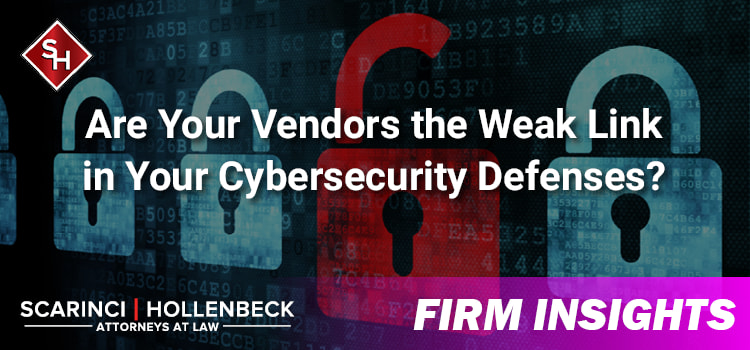
Scarinci Hollenbeck, LLC
The Firm
201-896-4100 info@sh-law.comAuthor: Scarinci Hollenbeck, LLC|May 26, 2021
As the SolarWinds breach made clear, one supply chain attack can wreak havoc on thousands of organizations. The wide-scale cyberattack also revealed how easily an entity’s IT systems can be compromised by the vulnerabilities of an entity’s software vendors and other third parties.
In 2020, a high-profile supply chain attack occurred against SolarWinds, a provider of network management software. The vendor was unknowingly hit with a malware attack and the breach resulted in the malicious code being inserted into a software update, which was then transmitted to 18,000 SolarWinds customers, including the U.S. Department of Defense, Department of Commerce, Microsoft, and Cisco. The code created a backdoor to the impacted entities’ information technology systems, which hackers then used to install additional malware that allowed them to spy on companies and government agencies. The hackers were undetected for months, with the breach first discovered by a cybersecurity firm that noticed its own system was compromised.
The SolarWinds Attack is the most high-profile and invasive IT software supply chain attack to date. It demonstrates how dangerous embedded malware inside a legitimate product can be. If left unchecked, it can allow hackers to access the networks of many organizations using one piece of code.
The SolarWinds attack, which has now been linked to Russian-backed hackers, resulted in numerous government investigations and hearings. Most recently, the New York State Department of Financial Services (NYDFS) released its report on the cyberattack.
The NYDS Report on the SolarWinds Supply Chain Attack summarizes the SolarWinds Attack, as well as the response by NYDFS-regulated companies. It also identifies four “key cybersecurity measures” that can reduce supply chain risk.
Overall, NYDFS found that companies under its oversight responded quickly. According to the report, 94 percent of the reporting companies removed the vulnerabilities from their IT systems within three days of the SolarWinds Attack’s announcement. However, NYDFS also found that some companies were not applying patches as regularly as needed to ensure timely remediation of high-risk cyber exposure.
Most importantly, the NYDFS identifies the following cybersecurity measures as critical practices when evaluating the risks posed by vendors and similar third parties (Third Party Service Providers):
As the NYDFS report notes, there is no silver bullet that will stop all supply chain attacks. Nonetheless, there are steps companies can take to reduce the risks posed by vendors and other third parties. We encourage all businesses to review their cyber security policies and procedures to ensure that include measures to mitigate third-party risk.
If you have any questions or if you would like to discuss the matter further, please contact me, Maryam Meseha, or the Scarinci Hollenbeck attorney with whom you work, at 201-896-4100.

The Firm
201-896-4100 info@sh-law.com
As the SolarWinds breach made clear, one supply chain attack can wreak havoc on thousands of organizations. The wide-scale cyberattack also revealed how easily an entity’s IT systems can be compromised by the vulnerabilities of an entity’s software vendors and other third parties.
In 2020, a high-profile supply chain attack occurred against SolarWinds, a provider of network management software. The vendor was unknowingly hit with a malware attack and the breach resulted in the malicious code being inserted into a software update, which was then transmitted to 18,000 SolarWinds customers, including the U.S. Department of Defense, Department of Commerce, Microsoft, and Cisco. The code created a backdoor to the impacted entities’ information technology systems, which hackers then used to install additional malware that allowed them to spy on companies and government agencies. The hackers were undetected for months, with the breach first discovered by a cybersecurity firm that noticed its own system was compromised.
The SolarWinds Attack is the most high-profile and invasive IT software supply chain attack to date. It demonstrates how dangerous embedded malware inside a legitimate product can be. If left unchecked, it can allow hackers to access the networks of many organizations using one piece of code.
The SolarWinds attack, which has now been linked to Russian-backed hackers, resulted in numerous government investigations and hearings. Most recently, the New York State Department of Financial Services (NYDFS) released its report on the cyberattack.
The NYDS Report on the SolarWinds Supply Chain Attack summarizes the SolarWinds Attack, as well as the response by NYDFS-regulated companies. It also identifies four “key cybersecurity measures” that can reduce supply chain risk.
Overall, NYDFS found that companies under its oversight responded quickly. According to the report, 94 percent of the reporting companies removed the vulnerabilities from their IT systems within three days of the SolarWinds Attack’s announcement. However, NYDFS also found that some companies were not applying patches as regularly as needed to ensure timely remediation of high-risk cyber exposure.
Most importantly, the NYDFS identifies the following cybersecurity measures as critical practices when evaluating the risks posed by vendors and similar third parties (Third Party Service Providers):
As the NYDFS report notes, there is no silver bullet that will stop all supply chain attacks. Nonetheless, there are steps companies can take to reduce the risks posed by vendors and other third parties. We encourage all businesses to review their cyber security policies and procedures to ensure that include measures to mitigate third-party risk.
If you have any questions or if you would like to discuss the matter further, please contact me, Maryam Meseha, or the Scarinci Hollenbeck attorney with whom you work, at 201-896-4100.